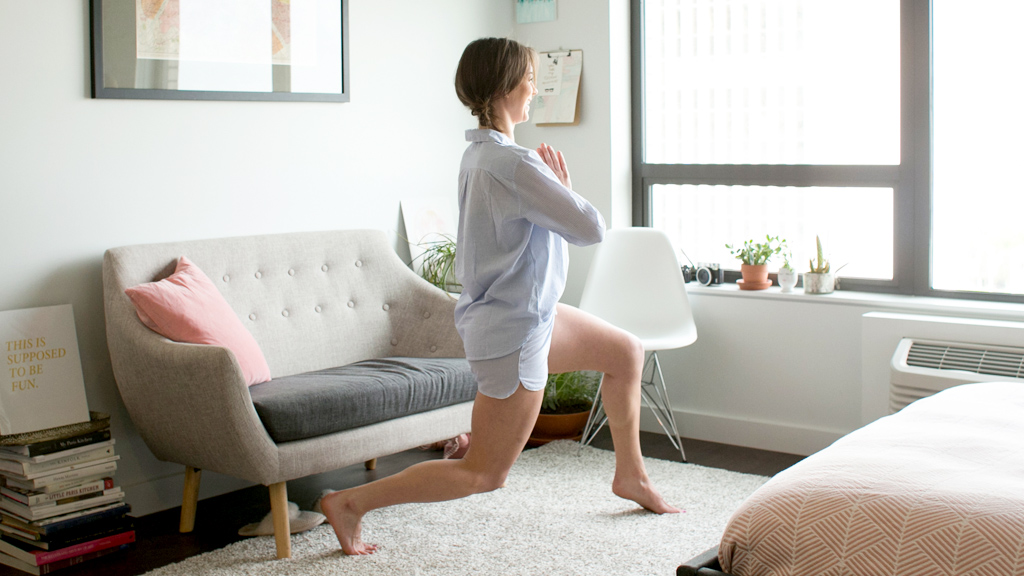Nourish
Why Sitting is Hazardous to Your Health – And What To Do About It
As you’re reading this, you’re probably sitting down. And if you’re like most Americans, you spend an average of 9.3 hours a day in this position. We sit at our computers, we sit at meetings, we sit in coffee shops, and we sit in the car. In fact, most people sit more than they sleep in a typical day.
That’s bad news for your body: Extended sitting slows the body’s metabolism and can cause your blood sugar to stay elevated, putting you at a greater risk for obesity and type 2 diabetes. It also increases fatigue, causes your joints to stiffen, puts you at a higher risk for injury, and wreaks havoc on your posture. When you stand, your mid-back muscles (specifically your rhomboids, mid traps, and lats), abdominals, and glute muscles keep you upright. But when you slump in a chair, they go unused and weaken. As a result, your body loses functional strength, flexibility decreases, and you’re more likely to experience chronic pain in your neck, lower-back, and hips.
So what’s the solution? Exercise is a great start, but unfortunately, it can’t undo all the damage caused by long hours of sitting. The trick is to get up and move, and to do it often. Health experts recommend getting up once an hour from your desk, even if it’s just to walk around briefly or go to the bathroom. You might also consider raising your desk to standing level or turning your next coffee meeting into a walking meeting.
One way to fill your day with movement and break up sitting time is to take advantage our 10-minute online or Mobile App workouts. Studies show that these mini workouts can decrease your appetite, help you focus, and melt stress. They also fuel weight loss. During a typical workout, your metabolism increases during exercise, burning more fat and calories as your heart rate elevates and your muscles work. This elevated metabolic boost doesn’t drop off immediately after exercise. It decreases over the next several hours. So while you may burn the same amount of calories in a 30-minute workout as you would during three 10-minute workouts, you burn calories all day long when you choose to do three shorter workouts. In the long run, you could easily zap more calories after three short sessions than one long one.
Now, we realize that everyone has to sit sometimes. In fact, we’re sitting down as we write this blog. But as soon as we finish, you can bet we’ll be popping up for a quick stretch and a stroll around the block. We hope we’ve inspired you to get up and move too!
As you’re reading this, you’re probably sitting down. And if you’re like most Americans, you spend an average of 9.3 hours a day in this position. We sit at our computers, we sit at meetings, we sit in coffee shops, and we sit in the car. In fact, most people sit more than they sleep in a typical day.
That’s bad news for your body: Extended sitting slows the body’s metabolism and can cause your blood sugar to stay elevated, putting you at a greater risk for obesity and type 2 diabetes. It also increases fatigue, causes your joints to stiffen, puts you at a higher risk for injury, and wreaks havoc on your posture. When you stand, your mid-back muscles (specifically your rhomboids, mid traps, and lats), abdominals, and glute muscles keep you upright. But when you slump in a chair, they go unused and weaken. As a result, your body loses functional strength, flexibility decreases, and you’re more likely to experience chronic pain in your neck, lower-back, and hips.
So what’s the solution? Exercise is a great start, but unfortunately, it can’t undo all the damage caused by long hours of sitting. The trick is to get up and move, and to do it often. Health experts recommend getting up once an hour from your desk, even if it’s just to walk around briefly or go to the bathroom. You might also consider raising your desk to standing level or turning your next coffee meeting into a walking meeting.
One way to fill your day with movement and break up sitting time is to take advantage our 10-minute online or Mobile App workouts. Studies show that these mini workouts can decrease your appetite, help you focus, and melt stress. They also fuel weight loss. During a typical workout, your metabolism increases during exercise, burning more fat and calories as your heart rate elevates and your muscles work. This elevated metabolic boost doesn’t drop off immediately after exercise. It decreases over the next several hours. So while you may burn the same amount of calories in a 30-minute workout as you would during three 10-minute workouts, you burn calories all day long when you choose to do three shorter workouts. In the long run, you could easily zap more calories after three short sessions than one long one.
Now, we realize that everyone has to sit sometimes. In fact, we’re sitting down as we write this blog. But as soon as we finish, you can bet we’ll be popping up for a quick stretch and a stroll around the block. We hope we’ve inspired you to get up and move too!










2 people have left a comment. Join the conversation!
View Comments